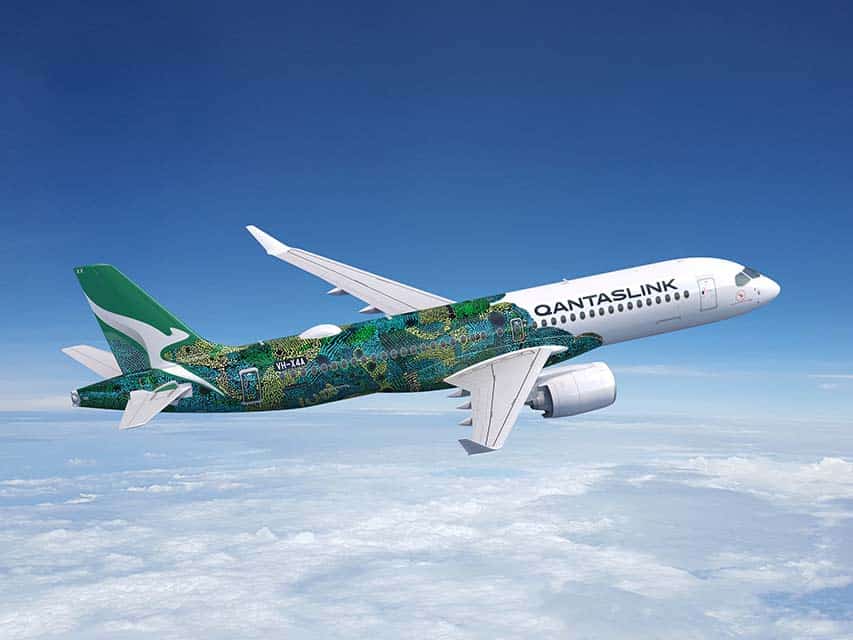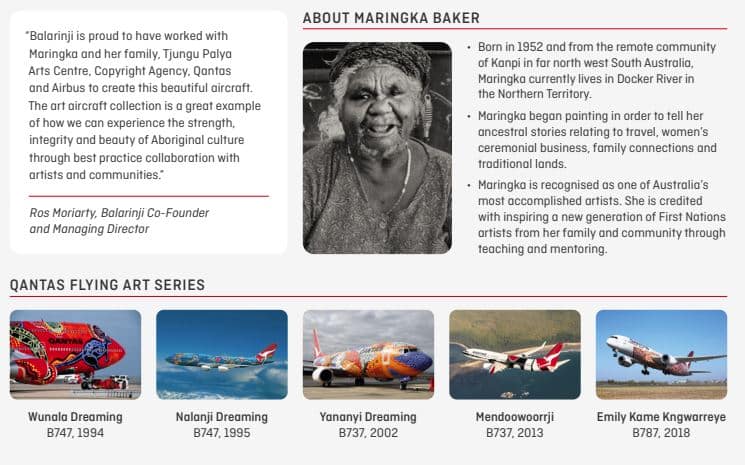Aerospace
The Story Behind QantasLink’s A220 Artwork ‘Minyma Kutjara Tjukurpa’
QantasLink’s Cultural Soar: Unveiling the Artistry of ‘Minyma Kutjara Tjukurpa’ on the A220

Every nation holds a unique tapestry of traditions passed down from ancestors, woven into the fabric of their living culture, and preserved through various mediums, such as paintings. Australia, too, boasts a rich cultural heritage and traditions, prominently displayed in entities like Qantas Airlines.
The airline consistently reflects the roots from which the country springs. Just yesterday, they unveiled a new A220 aircraft adorned with a distinctive painting, offering insight into the selection process for this artwork.
QantasLink recently revealed its inaugural Airbus A220 aircraft, fresh from the paint shop at Airbus’ facility in Mirabel, Canada. This marks a significant milestone in the Qantas Group’s initiative to renew its fleet. This particular aircraft, the first of 29 A220s slated for delivery as part of the domestic fleet renewal program, is scheduled to arrive in Australia by year-end.
Minyma Kutjara Tjukurpa Painting story.
A notable feature of this Qantas A220 aircraft is its unique painting titled ‘Minyma Kutjara Tjukurpa,’ the sixth installment in the Qantas-Balarinji Flying Art series. The artwork narrates the dream story of two sisters embarking on a journey back to their homeland.
The younger sister, lost in the south for an extended period, is guided north by her elder sister across vast landscapes. Along the way, the elder sister imparts knowledge about the land they traverse, and they pause to engage in Inma, a sacred ritual involving singing and dancing.

Initiated in 1995, the Flying Art Series has showcased six remarkable Aboriginal artworks across Qantas’ fleet. The renowned First Nation design agency, Balarinji, collaborated with Aboriginal artists and their representatives to develop these artworks.
The livery for ‘Minyma Kutjara Tjukurpa’ was specifically designed by Balarinji, and the aircraft (registration: VH-X4A) was meticulously painted by Airbus in Mirabel, Canada, a process taking over two weeks.
Approximately 100 painters, utilizing 130 stencils
The intricate design, featuring more than 20,000 dots, represents the most complex livery Airbus has ever undertaken for this aircraft type. Approximately 100 painters, utilizing 130 stencils, were involved in replicating the detailed Aboriginal designs.
Maringka Baker, a senior Pitjantjatjara artist from the remote community of Kanpi in far north-west South Australia, is the creative force behind ‘Minyma Kutjara Tjukurpa.’ Her artwork focuses on ancestral stories related to travel, women’s ceremonial practices, family ties, and traditional lands.
Recognized as one of Australia’s most accomplished artists, Maringka has played a pivotal role in inspiring a new generation of First Nations artists from her family and community through teaching and mentoring.
QantasLink A220 is configured with 137 seats
Following its painting in Canada, the aircraft will journey from Quebec to Australia, joining the QantasLink fleet. Its initial routes will connect Melbourne and Canberra. Six more A220s are slated for delivery by mid-2025.
The QantasLink A220 is configured with 137 seats in a two-cabin layout, comprising 10 Business seats and 127 Economy seats. These A220s are strategically positioned to connect smaller capital cities like Canberra and Hobart with major hubs in Brisbane, Melbourne, and Sydney.

Aerospace
When Ratan Tata was denied entry to the airfield at the Aero India show, he waited

During our visit to Aero India 2019, we had the unexpected opportunity to see Ratan Tata at the event, which was a thrilling moment for us. However, there was a surprising hiccup when the security staff didn’t allow him to enter due to a lack of a security pass.
Despite this, he remained calm and patiently waited for about 20 minutes until a member of the Tata team brought him the required pass, after which he calmly proceeded inside. It was a humbling sight, showcasing his composed demeanor even in such situations.
Ratan Tata ji is not only a renowned industrialist but also a trained pilot, holding a pilot’s license. In 2007, he became the first Indian civilian to fly the F-16 Falcon during the Aero India show in Bangalore—a proud moment for the nation.
His passion for aviation extended beyond flying, as he played a key role in shaping India’s aerospace industry. Under his leadership, Tata ventured into manufacturing and maintaining aerospace components while upholding its legacy of quality. Notably, Tata’s collaboration with Airbus to develop and manufacture the C295 aircraft is a testament to its growing influence in the sector.
-

 Aviation2 months ago
Aviation2 months agoMicrosoft Flight Simulator Raises $3 Million to Bring Back the An-225 Mriya
-

 Airlines2 months ago
Airlines2 months agoQantas Engineers Stage Walkout Over Cost of Living Concerns
-

 Airlines2 months ago
Airlines2 months agoQatar Citizens Can Travel to the United States Without a Visa
-

 Aviation2 months ago
Aviation2 months agoQatar Airways bans these new Electronic Devices on plane
-

 Airlines2 months ago
Airlines2 months agoJapan Airlines Rolls Out Free Domestic Flights to International Passengers
-

 Defence2 months ago
Defence2 months agoWhich Country Has the Largest Fleet of Fighter Aircraft?
-

 Airport2 months ago
Airport2 months agoWestern Sydney Airport Welcomes Its First Plane After 6 Years of construction
-

 Aviation2 months ago
Aviation2 months agoDid you know ? Once Boeing 747 carried 1088 passenger in 1991








